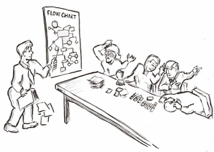Sort Articles:
October's Note From the Author
Written by: Ralph Twombly
Published: Wed Oct 21 2020 11:10:59 GMT-0400 (Eastern Daylight Time)
Welcome back. Another month in the books and Maine is displaying all of its color and beauty. God only knows, it has been a trying year. So, as we wait for remedies and possible vacines, here is the fourth installment of The Leadership Maker.
This month we bring you the important skill of Expectation Building.
This element of leadership has helped more leaders over the years than probably any other element. If the time is right, maybe it will help you.
Please enjoy The Leadership Maker...
The need
 One of the leading causes of failure in the workplace is unclear expectations. How do I know? In our leadership development work, we have found that the main reason why people don’t do what we want them to do is because they don't know what we want from them. I’ve had my own setbacks as a leader over the years and each time, I find that I didn’t give people clear expectations. People want to be successful and to do this they need to know what we expect from them. This done properly lowers the collective blood pressure, anxiety, and fear of failure in a group. Clear expectations and a sense of safety and trust can open a dialogue that leads to innovation and creativity. In addition, it gives you, as a leader, a means of accountability for you and for your direct reports. Expectations help in setting clear boundaries and encouraging people to try new things. People appreciate clear boundaries.
One of the leading causes of failure in the workplace is unclear expectations. How do I know? In our leadership development work, we have found that the main reason why people don’t do what we want them to do is because they don't know what we want from them. I’ve had my own setbacks as a leader over the years and each time, I find that I didn’t give people clear expectations. People want to be successful and to do this they need to know what we expect from them. This done properly lowers the collective blood pressure, anxiety, and fear of failure in a group. Clear expectations and a sense of safety and trust can open a dialogue that leads to innovation and creativity. In addition, it gives you, as a leader, a means of accountability for you and for your direct reports. Expectations help in setting clear boundaries and encouraging people to try new things. People appreciate clear boundaries.
Be Clear or Be Confusing
To develop and deliver your expectations to the individual, team, or group:
- This is an exercise that begins by having you determine the 5 to 7 expectations you will want from each of your people. Some of my favorites are captured below. Do this visually on a glass board, flipchart or in a handout (least preferred) to enhance the visual learning experience. By displaying this visually, the employees are more likely to remember the discussion. The document can also be something to hang in your office as a backdrop regular reminder.
- Once you are done presenting, check for clarity and answer questions honestly. If an expectation seems unfair, you may choose to re-word it with the individual or group. I recommend that you don’t give up something that feels important. If you keep it simple (limited details or bullet points), you will find a better outcome and less “splitting hairs” and disagreement on meaning.
- Get a visual acknowledgement from each member of the group or team via a nod or verbal agreement. Once they positively affirm, you have a person to person agreement. That is all that is required, and most people believe that a handshake is as good as a contract. Well, perhaps that is only true if you are not an attorney!
Receive their expectations
- This is the second part of the expectations exercise. After you are done with your expectations for them, start a second list of what they expect from you as their leader. Most groups will not request anything ridiculous or silly. You will find this is particularly true if you have stated your expectations first and keep them general and brief.
- As people speak, record everything verbatim, even if you don’t agree. You can clarify what you can and can’t agree to after their list is complete, but this is a moment to honor your audience and hear everyone.
- Go line by line through their expectations. Ask for clarity and express agreement only with to the things you are prepared to live with. Most leaders find that this list closely reflects what they have shared on their list previously in step one above.

You have two lists…now what?
- Hang your list in your office. Warning here - don’t put it on a banner or in a frame. This is a working document and you will find yourself making changes as time goes by and the needs of your team evolve. Use it when you talk to people who are succeeding or failing as it is a tool to strengthen strong performance or improve poor performance.
- Bring the list to each group or individual get together. From time to time, review the list and ask questions like, “How am I doing on your expectations?” This a good way to remind your people that you are listening, and it also reinforces your expectations to them.
Some of my favorite expectations are:
- Be here when you are here - participate, be present and positive.
- Be productive, play in the team and plan for your growth.
- Always bring your suggestions with any complaint or concern.
- Before you rely on me as a conflict mediator, try to work it one to one. If you need coaching, I’m honored to help.
- Place the team first. Take care of the person to your right and left.
- Have fun, laugh and make the work easier for yourself and others every day.
Summary from October and November newsletter articles
- Leaders need followers and they need us to be strong and straight. People are too smart to blindly follow the weak and broken. Create your words and live those words every day in every way. Do this not just at work but in all aspects of your life and people will follow.
- All people are motivated by the same things. This isn’t just about millennials or baby boomers. We all want appreciation for our hard work, and we want a voice in the things that we give so much of our lives to. We all want to build our careers and have meaningful work.
- You can learn positive observation skills. They will change the way you think, and act and they will change the way that others see you as a leader.
- Understand the distribution of people around 10/80/10. This It will help you decide who and what to spend your time on. Never ignore your problems, but don’t let them consume you. Your people will pay and eventually they will make you pay. They need you.
- Adopt, write, rewrite and live a few cherished values. Like positive observation skills, they will change your life. Please don’t complicate your list. Live it.
- Give and receive expectations routinely and use them to hold yourself and others accountable. This will build trust and solidify you as someone who others want to follow.
Ralph Twombly
In the 20 years since starting Priority Learning, Ralph has facilitated countless learning experiences and has conducted training for thousands of managers and leaders. With over 30 years of leadership development and organizational development background and work, Ralph continues to build relationships with client companies all over the U.S.
M. Gagnon

